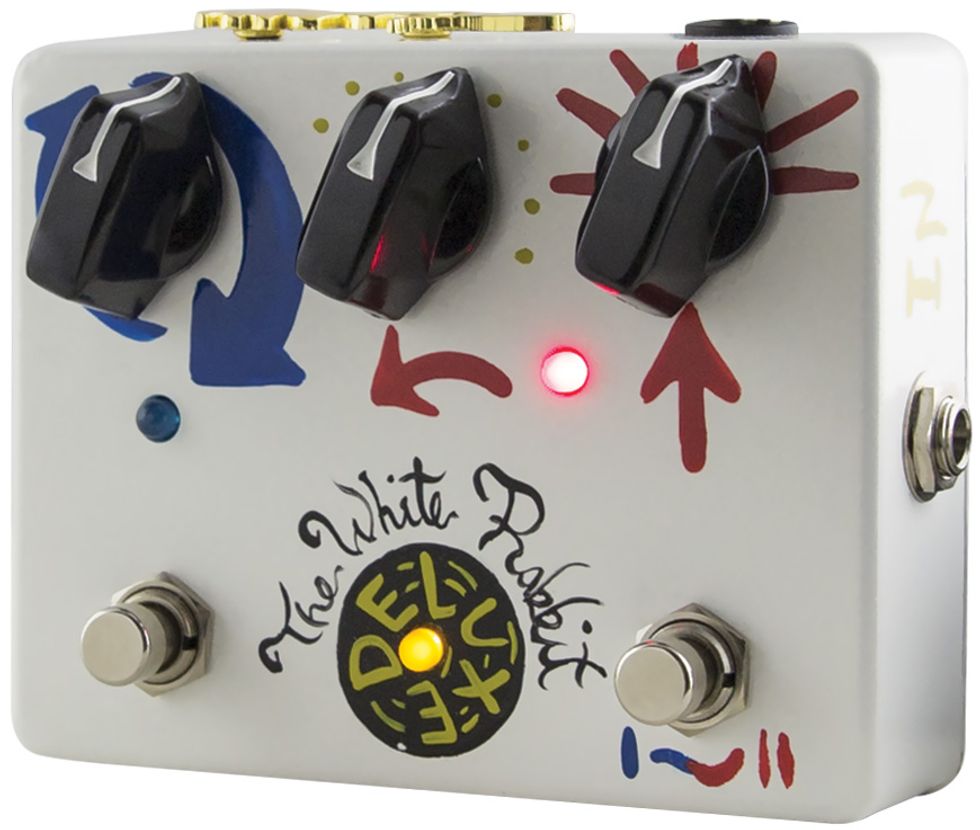RatingsPros:Adds subtle but perceptible clarity. Unusual crunch tones. Interesting tagboard build. Cons: Uneven control response. Street: $235 Terry Audio White Rabbit terryaudio.com | Tones: Ease of Use: Build/Design: Value: |
Some studio consoles and tape machines are famed for their ability to improve sound quality simply by routing a signal through them. The White Rabbit pedal from Terry Audio aspires to similar magic via stompbox.
Changing Channels
Described as a “vintage line amplifier,” the White Rabbit is a relatively subtle gain circuit—at most settings, anyway. It’s got two channels, “blue” and “red.” Blue is milder, red is wilder. One footswitch activates the effect, while the other toggles between blue and red. (You can’t stack channels). Blue/red LEDs indicate the active channel. Clever detail: The LEDs glow even when the effect is bypassed, so you know which channel you’ll hear when you activate. The Rabbit feeds on conventional 9V power supplies. There’s no battery compartment.
Now, those classic consoles and tape machines usually process guitar sounds that have already passed through amps and microphones. What effect does the White Rabbit create between your guitar and amp? With vintage-output pickups and a retro-ish tube amp, the White Rabbit compensates for signal loss resulting from the capacitive relationship between guitar and amp. It adds a sheen of treble presence and a sense of headroom. It reminds me of what happens when you switch from a cheapo guitar cable to one of those low-capacitance ones that sell for ten bucks per foot.
Rabbit Punches
As you advance the blue channel knob, tone changes are subtle—until you reach the last 10 percent of the pot’s range, where things get very dirty, very quickly. You can hear the process in my first audio clip. I play a short phrase five times: first with the pedal bypassed, and then activated with the blue knob at its 25-, 50-, 75-, and 100-percent positions.
You might view this lopsided gain curve as the result of a poorly chosen pot taper, or just consider this channel a clean-toned clarifier with a monster in its attic. The blown-out blue channel barfs fat, edgy distortion with a crisp treble edge. My second audio clip highlights this tone. I start out bypassed before stumbling through a couple of bonehead riffs. (Yeah, there’s a bit of switch noise.) I can imagine many uses for this fat-yet-articulate flavor.
The red channel’s dual controls provide a wider range of overdrive. Advancing the knobs increases both distortion and compression. Maximum settings generate weird-cool tones marked by gasping compression, saggy response, and glitchy artifacts. My third audio clip showcases some possibilities. Again, the control response is not symmetric. Most of the action occurs near the bottom of the first knob’s range and near the top of the second’s.
Tagboard, You’re It
The White Rabbit’s build technique is noteworthy. There’s no circuit board. Instead, the 12 modest components (including two silicon transistors whose part numbers have been obscured) are point-to-point wired via grommets inserted in heavy tagboard. This method was used in some vintage amplifiers, and there’s no reason to doubt its durability. All wires are cloth-coated, as in the control cavities of vintage guitars. I’ve never encountered evidence that such construction enhances tone—at least not in simple 9V circuits. But it sure looks nifty. (Tagboard builds are rare in commercial stompboxes, but popular in the DIY community.)
The Verdict
The White Rabbit isn’t your typical crunch critter. At modest settings it adds subtle but meaningful clarity and brightness. Higher settings yield cool crunch tones as unconventional as the pedal’s point-to-point tagboard build. At $235, the Rabbit isn’t exactly a bargain bunny. But that’s a fair sum for an artfully handwired stompbox.








![Rig Rundown: Russian Circles’ Mike Sullivan [2025]](https://www.premierguitar.com/media-library/youtube.jpg?id=62303631&width=1245&height=700&quality=70&coordinates=0%2C0%2C0%2C0)


























